Nature-Inspired Gradient Material Structure with Exceptional Properties for Automotive Parts
Abstract
1. Introduction
2. Gradient Structure in Biological System
2.1. Design Principles of Biological Gradient Materials in Animals
2.1.1. Chemical Compositions
2.1.2. Structural Characteristics
2.1.3. Exoskeleton of Homarus Americanus Lobster
2.2. Design Principles of Biological Gradient Materials Inplants
2.2.1. Moso Bamboo’s Gradient Distribution
2.2.2. Mechanical Tests and Microstructure Investigation on Bamboo Wall
3. Current Manufacturing Processes
4. Material Strengthening Methodology
4.1. Hetero-Deformation-Induced Hardening
- At first stage, external stress is small. Elastic deformations exist in the hard and soft domains.
- As shown in Figure 15, At second stage, as the external stress increases, soft grains begin to initiate plastic deformation through dislocation slip, while the hard grains remain elastically deformed. Plastic incompatibility occurs at the heterointerface, which leads to accumulation of interfacial geometrically necessary dislocations (GNDs) causing strain gradients (in the soft domain). Accumulation of the GNDs creates long-range back-stress (internal stress, opposite to the external stress) in soft domain. At the same time, the back-stress induces forward-stress (internal stress, same direction as the external stress) in the hard domain. Particularly, the back-stress and the forward-stress act as a pair of co-existing stresses in the heterointerface; they are the same in magnitude, but in opposite direction.In the case of increasing external stress, ductility of soft domain is enhanced through continuous accumulation of the GNDs, and the back-stress generated by the accumulation of the GNDs also improves strength of soft domain.In the hard domain, direction of the forward-stress is the same as the external stress, and the forward-stress induces deformation and “softening” of the hard domain (under the action of a certain external stress, the forward-stress makes the hard domain deform more and improves ductility of the hard domain). However, in this stage, the external stress is limited, accumulation of interfacial GNDs is limited, the back-stress is limited, and the forward-stress is limited. The forward-stress and the external stress are not enough to make the hard domain deform. So, the effect of the forward-stress in the hard domain is only a tendency (the forward-stress makes the hard domain near the interfaces easier to yield).
- As shown in Figure 15, At third stage, the external stress and the forward-stress are enough, plastic deformations exist in the hard and soft domains. Situation in the soft domain is similar to that in the second stage: in the case of the increasing external stress, ductility of the soft domain is enhanced through continuous accumulation of the GNDs, and the back-stress generated by the accumulation of the GNDs also improves the strength of the soft domain. Situation in the hard domain is different from in second stage: the forward-stress makes the hard domain deform more under certain external stress and improves the ductility of the hard domain.
4.2. Hydrogen Embrittlement
4.3. Precipitation Hardening
5. Proposed Approach Based on Gradient Structure and Multi-Material SLM
5.1. Research Status
5.2. Solutions
6. Conclusions
- Inspired by biological gradient structures such as lobster exoskeletons and bamboo, this work proposes an advanced material design strategy for automotive applications. The integration of HDI hardening and precipitation hardening effectively enhances both strength and ductility, overcoming the traditional strength–ductility trade-off.
- The study demonstrates that bioinspired gradient-structured materials, combined with tailored post-processing, can achieve ultrahigh strength, excellent ductility, and superior energy absorption, meeting the lightweight and performance requirements of modern automotive engineering.
Funding
Institutional Review Board Statement
Informed Consent Statement
Data Availability Statement
Conflicts of Interest
References
- De Moor, E.; Gibbs, P.J.; Speer, J.G.; Matlock, D.K.; Schroth, J.G. Strategies for third-generation advanced high-strength steel development. AIST Trans. 2010, 7, 133–144. [Google Scholar]
- Ivkovic, D.; Adamovic, D.; Arsić, D.; Ratkovic, N.; Nikolic, R. Review of the first generation of the advanced high-strength steels (AHSS) and their manufacturing procedures. In Proceedings of the 39th International Conference on Production Engineering of Serbia, Novi Sad, Serbia, 26–27 October 2023. [Google Scholar]
- Connolly, D. A New Crystal Plasticity Model for Steels Exhibiting Transformation Induced Plasticity with Application to Quenched and Partitioned Steel. 2021. Available online: https://uwspace.uwaterloo.ca/items/32e24af5-c577-40d7-a264-fc195cc3ac9d (accessed on 28 August 2025).
- Okur, O.; Davut, K.; Palumbo, G.; Nalcaci, B.; Guglielmi, P.; Yalcin, M.A.; Calin, R.; Erdogan, M. Chemical Composition Optimization and Isothermal Transformation of δ-Transformation-Induced Plasticity Steel for the Third-Generation Advanced High-Strength Steel Grade. Steel Res. Int. 2024, 96, 2400648. [Google Scholar] [CrossRef]
- Soleimani, M.; Kalhor, A.; Mirzadeh, H. Transformation-induced plasticity (TRIP) in advanced steels: A review. Mater. Sci. Eng. A 2020, 795, 140023. [Google Scholar] [CrossRef]
- Meknassi, R.F.; Miklós, T. Third generation of advanced high strength sheet steels for the automotive sector: A literature review. Multidiszcip. Tudományok 2021, 11, 241–247. [Google Scholar]
- Shamsujjoha, M.; Enloe, C.M.; Chuang, A.C.; Coryell, J.J.; Ghassemi-Armaki, H. Mechanisms of paint bake response in resistance spot-welded first and third generation AHSS. Materialia 2021, 15, 100975. [Google Scholar] [CrossRef]
- Raabe, D.; Sachs, C.; Romano, P. The crustacean exoskeleton as an example of a structurally and mechanically graded biological nanocomposite material. Acta Mater. 2005, 53, 4281–4292. [Google Scholar] [CrossRef]
- Dixon, P.G.; Gibson, L.J. The structure and mechanics of Moso bamboo material. J. R. Soc. Interface. 2014, 11, 20140321. [Google Scholar] [CrossRef]
- Wegst, U.G. Bending efficiency through property gradients in bamboo, palm, and wood-based composites. J. Mech. Behav. Biomed. Mater. 2011, 4, 744–755. [Google Scholar] [CrossRef]
- Shao, Z.-P.; Fang, C.-H.; Huang, S.-X.; Tian, G.-L. Tensile properties of Moso bamboo (Phyllostachys pubescens) and its components with respect to its fiber-reinforced composite structure. Wood Sci. Technol. 2010, 44, 655–666. [Google Scholar] [CrossRef]
- Zhu, Y.; Wu, X. Perspective on hetero-deformation induced (HDI) hardening and back stress. Mater. Res. Lett. 2019, 7, 393–398. [Google Scholar] [CrossRef]
- Zhu, Y.; Ameyama, K.; Anderson, P.M.; Beyerlein, I.J.; Gao, H.; Kim, H.S.; Lavernia, E.; Mathaudhu, S.; Mughrabi, H.; Ritchie, R.O.; et al. Heterostructured materials: Superior properties from hetero-zone interaction. Mater. Res. Lett. 2021, 9, 1–31. [Google Scholar] [CrossRef]
- Ren, J.; Zhang, Y.; Zhao, D.; Chen, Y.; Guan, S.; Liu, Y.; Liu, L.; Peng, S.; Kong, F.; Poplawsky, J.D. Strong yet ductile nanolamellar high-entropy alloys by additive manufacturing. Nature 2022, 608, 62–68. [Google Scholar] [CrossRef]
- Wu, S.W.; Wang, G.; Wang, Q.; Jia, Y.D.; Yi, J.; Zhai, Q.J.; Liu, J.B.; Sun, B.A.; Chu, H.J.; Shen, J. Enhancement of strength-ductility trade-off in a high-entropy alloy through a heterogeneous structure. Acta Mater. 2019, 165, 444–458. [Google Scholar] [CrossRef]
- Liu, D.; Jin, X.; Guo, N.; Liaw, P.K.; Qiao, J.W. Non-equiatomic FeMnCrNiAl high-entropy alloys with heterogeneous structures for strength and ductility combination. Mater. Sci. Eng. A 2021, 818, 141386. [Google Scholar] [CrossRef]
- Lu, W.; Yan, K.; Luo, X.; Wang, Y.; Hou, L.; Li, P.; Huang, B.; Yang, Y. Superb strength and ductility balance of a Co-free medium-entropy alloy with dual heterogeneous structures. J. Mater. Sci. Technol. 2022, 98, 197–204. [Google Scholar] [CrossRef]
- Gao, B.; Zhao, H.; Peng, L.; Sun, Z. A review of research progress in selective laser melting (SLM). Micromachines 2022, 14, 57. [Google Scholar] [CrossRef] [PubMed]
- Jia, H.; Sun, H.; Wang, H.; Wu, Y.; Wang, H. Scanning strategy in selective laser melting (SLM): A review. Int. J. Adv. Manuf. Technol. 2021, 113, 2413–2435. [Google Scholar] [CrossRef]
- Sefene, E.M. State-of-the-art of selective laser melting process: A comprehensive review. J. Manuf. Syst. 2022, 63, 250–274. [Google Scholar] [CrossRef]
- Hamza, A.; Bousnina, K.; Dridi, I.; Ben Yahia, N. Revolutionizing Automotive Design: The Impact of Additive Manufacturing. Vehicles 2025, 7, 24. [Google Scholar] [CrossRef]
- Mao, L.-B.; Meng, Y.-F.; Meng, X.-S.; Yang, B.; Yang, Y.-L.; Lu, Y.-J.; Yang, Z.-Y.; Shang, L.-M.; Yu, S.-H. Matrix-Directed Mineralization for Bulk Structural Materials. J. Am. Chem. Soc. 2022, 144, 18175–18194. [Google Scholar] [CrossRef] [PubMed]
- Vasco, J.C. Additive manufacturing for the automotive industry. In Additive Manufacturing; Elsevier: Amsterdam, The Netherlands, 2021; pp. 505–530. [Google Scholar]
- Liu, Z.; Meyers, M.A.; Zhang, Z.; Ritchie, R.O. Functional gradients and heterogeneities in biological materials: Design principles, functions, and bioinspired applications. Prog. Mater. Sci. 2017, 88, 467–498. [Google Scholar] [CrossRef]
- Cheng, Z.; Bu, L.; Zhang, Y.; Wu, H.; Zhu, T.; Lu, L. Characterization of gradient plastic deformation in gradient nanotwinned Cu. Acta Mater. 2023, 246, 118673. [Google Scholar] [CrossRef]
- Zhang, E.T.; Liu, H.; Ng, B.F. Mechanics of re-entrant anti-trichiral honeycombs with nature-inspired gradient distributions. Int. J. Mech. Sci. 2023, 259, 108597. [Google Scholar] [CrossRef]
- Weaver, J.C.; Wang, Q.; Miserez, A.; Tantuccio, A.; Stromberg, R.; Bozhilov, K.N.; Maxwell, P.; Nay, R.; Heier, S.T.; DiMasi, E. Analysis of an ultra hard magnetic biomineral in chiton radular teeth. Mater. Today 2010, 13, 42–52. [Google Scholar] [CrossRef]
- Miserez, A.; Li, Y.; Waite, J.H.; Zok, F. Jumbo squid beaks: Inspiration for design of robust organic composites. Acta Biomater. 2007, 3, 139–149. [Google Scholar] [CrossRef]
- Pontin, M.G.; Moses, D.N.; Waite, J.H.; Zok, F.W. A nonmineralized approach to abrasion-resistant biomaterials. Proc. Natl. Acad. Sci. USA 2007, 104, 13559–13564. [Google Scholar] [CrossRef]
- Tan, Y.; Hoon, S.; Guerette, P.A.; Wei, W.; Ghadban, A.; Hao, C.; Miserez, A.; Waite, J.H. Infiltration of chitin by protein coacervates defines the squid beak mechanical gradient. Nat. Chem. Biol. 2015, 11, 488–495. [Google Scholar] [CrossRef]
- Sun, C.-Y.; Chen, P.-Y. Structural design and mechanical behavior of alligator (Alligator mississippiensis) osteoderms. Acta Biomater. 2013, 9, 9049–9064. [Google Scholar] [CrossRef]
- Kasapi, M.A.; Gosline, J.M. Design complexity and fracture control in the equine hoof wall. J. Exp. Biol. 1997, 200, 1639–1659. [Google Scholar] [CrossRef]
- Liu, Z.Q.; Jiao, D.; Weng, Z.Y.; Zhang, Z.F. Structure and mechanical behaviors of protective armored pangolin scales and effects of hydration and orientation. J. Mech. Behav. Biomed. Mater. 2016, 56, 165–174. [Google Scholar] [CrossRef] [PubMed]
- Ho, S.P.; Marshall, S.J.; Ryder, M.I.; Marshall, G.W. The tooth attachment mechanism defined by structure, chemical composition and mechanical properties of collagen fibers in the periodontium. Biomaterials 2007, 28, 5238–5245. [Google Scholar] [CrossRef]
- Tomppo, E.; Katila, M.; Makisara, K.; Malimbwi, R.; Chamuya, N.; Otieno, J.; Dalsgaard, S.; Leppanen, M. A Report to the Food and Agriculture Organization of the United Nations (FAO) in Support of Sampling Study for National Forestry Resources Monitoring and Assessment (NAFORMA) in Tanzania. 2010. Available online: https://www.academia.edu/99175689/A_report_to_the_food_and_agriculture_organization_of_the_united_nations_FAO_in_support_of_sampling_study_for_National_Forestry_Resources_Monitoring_and_Assessment_NAFORMA_in_Tanzania (accessed on 8 August 2025).
- Armstrong, M.; Mehrabi, H.; Naveed, N. An overview of modern metal additive manufacturing technology. J. Manuf. Process. 2022, 84, 1001–1029. [Google Scholar] [CrossRef]
- Blakey-Milner, B.; Gradl, P.; Snedden, G.; Brooks, M.; Pitot, J.; Lopez, E.; Leary, M.; Berto, F.; Du Plessis, A. Metal additive manufacturing in aerospace: A review. Mater. Des. 2021, 209, 110008. [Google Scholar] [CrossRef]
- Mobarak, M.H.; Islam, M.A.; Hossain, N.; Al Mahmud, M.Z.; Rayhan, M.T.; Nishi, N.J.; Chowdhury, M.A. Recent advances of additive manufacturing in implant fabrication–a review. Appl. Surf. Sci. Adv. 2023, 18, 100462. [Google Scholar] [CrossRef]
- Ramakrishna, S.; Ramasubramanian, B. Effective Waste Management Strategies and Circularity of Plastics. In Handbook of Materials Circular Economy; Springer Nature: Singapore, 2024; pp. 97–130. [Google Scholar] [CrossRef]
- Cheng, Z.; Zhou, H.; Lu, Q.; Gao, H.; Lu, L. Extra strengthening and work hardening in gradient nanotwinned metals. Science 2018, 362, eaau1925. [Google Scholar] [CrossRef] [PubMed]
- Li, H.; Cheng, Y.; Wang, Z.; Wang, X. Physics-Informed Neural Networks for Depth-Dependent Constitutive Relationships of Gradient Nanostructured 316L Stainless Steel. Materials 2025, 18, 3532. [Google Scholar] [CrossRef] [PubMed]
- Wu, X.; Zhu, Y. Heterogeneous materials: A new class of materials with unprecedented mechanical properties. In Heterostructured Materials; Jenny Stanford Publishing: Singapore, 2021; pp. 3–16. [Google Scholar]
- Jiang, W.; Zhu, Y.; Zhao, Y. Mechanical properties and deformation mechanisms of heterostructured high-entropy and medium-entropy alloys: A review. Front. Mater. 2022, 8, 792359. [Google Scholar] [CrossRef]
- Liu, X.; Nakatani, M.; Gao, H.; Sharma, B.; Pan, H.; Fu, Z.; Li, X.; Ameyama, K.; Zhu, X. Effect of stacking fault energy on deformation mechanisms in Cu and Cu-30% Zn alloy with gradient structure obtained by SMAT. J. Alloys Compd. 2021, 865, 158863. [Google Scholar] [CrossRef]
- Valiev, R.Z.; Alexandrov, I.V.; Kawasaki, M.; Langdon, T.G. Synthesis of Bulk Nanostructured Metal Systems. In Ultrafine-Grained Materials; The Minerals, Metals & Materials Series; Springer International Publishing: Cham, Switzerland, 2024; pp. 95–140. [Google Scholar] [CrossRef]
- Zhang, L.; Yuan, Q.; Tan, J.; Dong, Q.; Lv, H.; Wang, F.; Tang, A.; Eckert, J.; Pan, F. Enhancing the room-temperature plasticity of magnesium alloys: Mechanisms and strategies. J. Magnes. Alloys 2024, 12, 4741–4767. [Google Scholar] [CrossRef]
- Qiang, W.; Wu, Q.; Long, L. Shear bands and interface-affected-zone enabled high strength and ductility in heterogeneous laminate-Cu. Mater. Today Commun. 2024, 40, 109541. [Google Scholar] [CrossRef]
- Huang, C.X.; Wang, Y.F.; Ma, X.L.; Yin, S.; Höppel, H.W.; Göken, M.; Wu, X.L.; Gao, H.J.; Zhu, Y.T. Interface affected zone for optimal strength and ductility in heterogeneous laminate. Mater. Today 2018, 21, 713–719. [Google Scholar] [CrossRef]
- Liu, C.; Wang, Y.; Zhang, Y.; Wang, L. Additively Manufactured High-Entropy Alloys: Exceptional Mechanical Properties and Advanced Fabrication. Acta Metall. Sin. (Engl. Lett.) 2024, 37, 3–16. [Google Scholar] [CrossRef]
- Max-Planck-Institut Für Eisenforschung (2023) Hydrogen Embrittlement in High-Performance Alloys. Available online: https://www.mpie.de/4604692/hydrogen_embrittlement (accessed on 25 September 2023).
- Korlapati, N.V.S.; Khan, F.; Vaddiraju, S.; Cagin, T. Hydrogen diffusion dynamics on Fe (100) surface: A mechanism of hydrogen-induced failure. Int. J. Hydrogen Energy 2024, 65, 177–185. [Google Scholar] [CrossRef]
- Huang, S.; Hui, H.; Peng, J. Prediction of hydrogen-assisted fracture under coexistence of hydrogen-enhanced plasticity and decohesion. Int. J. Hydrogen Energy 2023, 48, 36987–37000. [Google Scholar] [CrossRef]
- de Loureiro, R.C.P.; Cardoso, J.L.; da Silva Lima, M.N.; Béreš, M.; Masoumi, M.; Tavares, S.S.M.; de Abreu, H.F.G. Hydrogen-enhanced localized plasticity in pearlitic steel exposed to H2S: A crystallographic and fracture mechanics study. Eng. Fail. Anal. 2025, 181, 109926. [Google Scholar] [CrossRef]
- Feng, L.; Tang, W.; Chen, Z.; Zhang, X.; Zhang, Y.-W.; Li, W.; Xiang, M.; Yao, X. Atomistic insights into hydrogen-enhanced strain-induced vacancy in α-iron across varied strain rates. Scr. Mater. 2024, 252, 116246. [Google Scholar] [CrossRef]
- Zhang, Q.; Zhou, C.; Meng, X.; Li, J.; Chen, J.; Lv, X.; Wu, L.; Cao, F.; Sun, Q. Hydrogen embrittlement and hydrogen-dislocation interactions in Ni-Cr alloys. Corros. Sci. 2025, 256, 113180. [Google Scholar] [CrossRef]
- Lynch, S. Hydrogen embrittlement phenomena and mechanisms. Corros. Rev. 2012, 30, 105–123. [Google Scholar] [CrossRef]
- Du, X.H.; Li, W.P.; Chang, H.T.; Yang, T.; Duan, G.S.; Wu, B.L.; Huang, J.C.; Chen, F.R.; Liu, C.T.; Chuang, W.S. Dual heterogeneous structures lead to ultrahigh strength and uniform ductility in a Co-Cr-Ni medium-entropy alloy. Nat. Commun. 2020, 11, 2390. [Google Scholar] [CrossRef]
- Song, M.; Zhou, R.; Gu, J.; Wang, Z.; Ni, S.; Liu, Y. Nitrogen induced heterogeneous structures overcome strength-ductility trade-off in an additively manufactured high-entropy alloy. Appl. Mater. Today 2020, 18, 100498. [Google Scholar] [CrossRef]
- Laleh, M.; Sadeghi, E.; Revilla, R.I.; Chao, Q.; Haghdadi, N.; Hughes, A.E.; Xu, W.; De Graeve, I.; Qian, M.; Gibson, I. Heat treatment for metal additive manufacturing. Prog. Mater. Sci. 2023, 133, 101051. [Google Scholar] [CrossRef]
- Teixeira, Ó.; Silva, F.J.; Ferreira, L.P.; Atzeni, E. A review of heat treatments on improving the quality and residual stresses of the Ti–6Al–4V parts produced by additive manufacturing. Metals 2020, 10, 1006. [Google Scholar] [CrossRef]
- Rosenthal, I.; Shneck, R.; Stern, A. Heat treatment effect on the mechanical properties and fracture mechanism in AlSi10Mg fabricated by additive manufacturing selective laser melting process. Mater. Sci. Eng. A 2018, 729, 310–322. [Google Scholar] [CrossRef]
- Chen, X.; Li, J.; Cheng, X.; Wang, H.; Huang, Z. Effect of heat treatment on microstructure, mechanical and corrosion properties of austenitic stainless steel 316L using arc additive manufacturing. Mater. Sci. Eng. A 2018, 715, 307–314. [Google Scholar] [CrossRef]
- Motallebi, R.; Savaedi, Z.; Mirzadeh, H. Post-processing heat treatment of lightweight magnesium alloys fabricated by additive manufacturing: A review. J. Mater. Res. Technol. 2022, 20, 1873–1892. [Google Scholar] [CrossRef]
- Barath Kumar, M.D.; Manikandan, M. Assessment of Process, Parameters, Residual Stress Mitigation, Post Treatments and Finite Element Analysis Simulations of Wire Arc Additive Manufacturing Technique. Met. Mater. Int. 2022, 28, 54–111. [Google Scholar] [CrossRef]
- Brennan, M.C.; Keist, J.S.; Palmer, T.A. Defects in Metal Additive Manufacturing Processes. J. Mater. Eng. Perform. 2021, 30, 4808–4818. [Google Scholar] [CrossRef]
- Cui, Y.; Li, J.; Yim, S.; Yamanaka, K.; Aoyagi, K.; Wang, H.; Chiba, A. Multi-material additive manufacturing of steel/Al alloy by controlling the liquid/solid interface in laser beam powder bed fusion. Addit. Manuf. 2024, 96, 104529. [Google Scholar] [CrossRef]
- Wu, X.; Zhang, D.; Yi, D.; Hu, S.; Huang, G.; Poprawe, R.; Schleifenbaum, J.H. Interfacial characterization and reaction mechanism of Ti/Al multi-material structure during laser powder bed fusion process. Mater. Charact. 2022, 192, 112195. [Google Scholar] [CrossRef]
- Miao, H.; Yusof, F.; Ab Karim, M.S.; Wu, B.; Raja, S.; Ibrahim, M.Z.; Aziz, I.; Chen, D. Interfacial microstructure, element diffusion, mechanical properties and metallurgical bonding mechanism of 316L-AlSi10Mg multi-material parts fabricated by laser powder bed fusion. J. Mater. Res. Technol. 2023, 26, 8351–8365. [Google Scholar] [CrossRef]
- Huang, G.; Gu, D.; Liu, H.; Lin, K.; Wang, J.; Sun, H.; Guo, Z. The effect of thermal history on elemental diffusion, phase evolution, and mechanical properties of laser powder bed fusion fabricated Ti6Al4V/AlMgScZr multi-material components. Addit. Manuf. 2025, 107, 104821. [Google Scholar] [CrossRef]
- Zhang, X.; Mao, M.; Wang, W.; Liang, J.; Liang, X.; Zhang, Z.; Liang, Z. Exceptional strength and ductility in 18Ni300/316 L heterogeneous bionic structures through laser additive manufacturing. Mater. Charact. 2025, 227, 115296. [Google Scholar] [CrossRef]
- Ma, Y.; Gao, Y.; Zhao, L.; Li, D.; Men, Z. Optimization of process parameters and analysis of microstructure and properties of 18Ni300 by selective laser melting. Materials 2022, 15, 4757. [Google Scholar] [CrossRef]
- Ferreira, D.F.S.; Miranda, G.; Oliveira, F.J.; Oliveira, J.M. Conventionally and SLM-manufactured 18Ni300 steel: Mechanical and tribological behaviour in dry sliding against PP40 composite. Int. J. Adv. Manuf. Technol. 2022, 122, 1245–1258. [Google Scholar] [CrossRef]
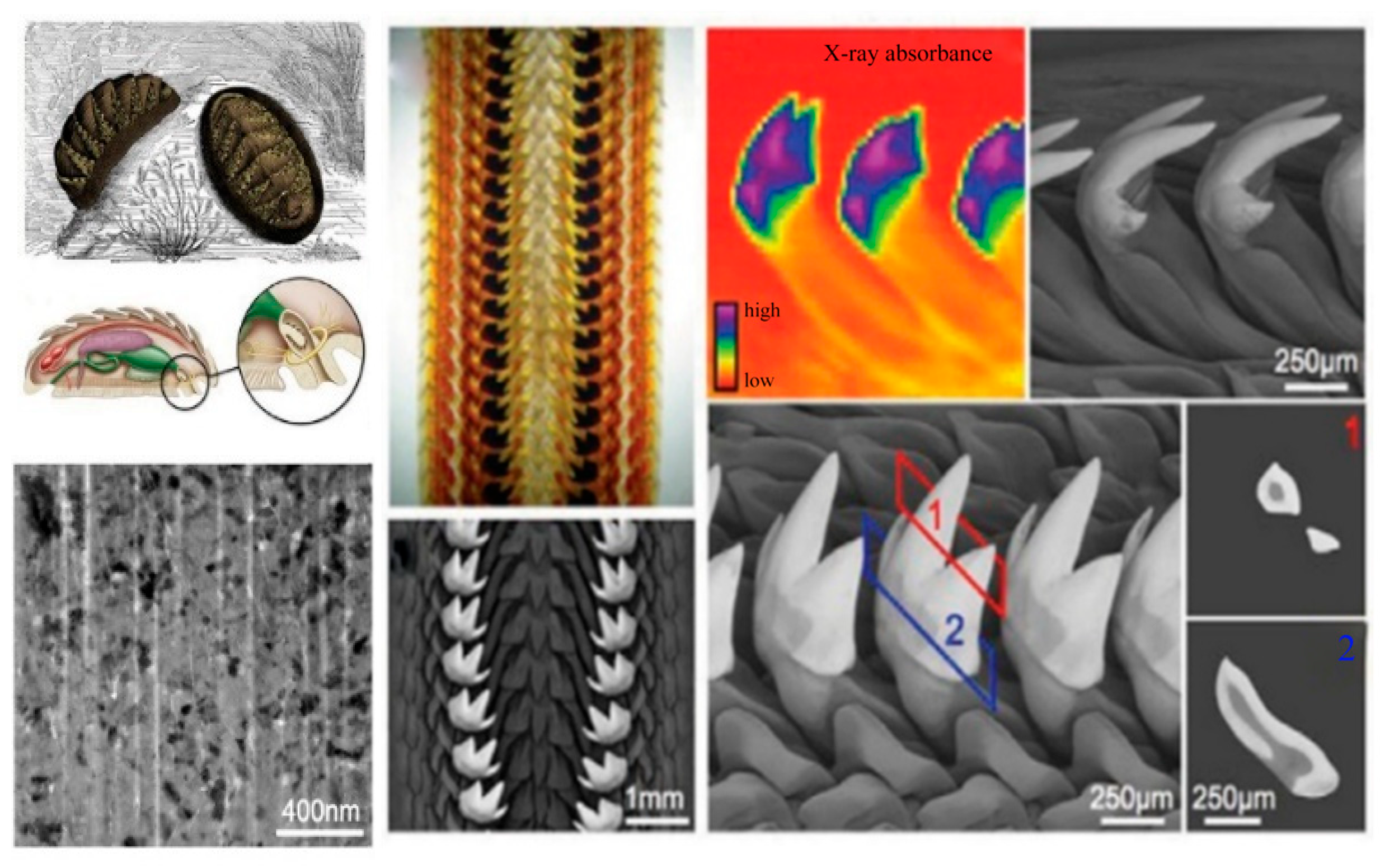
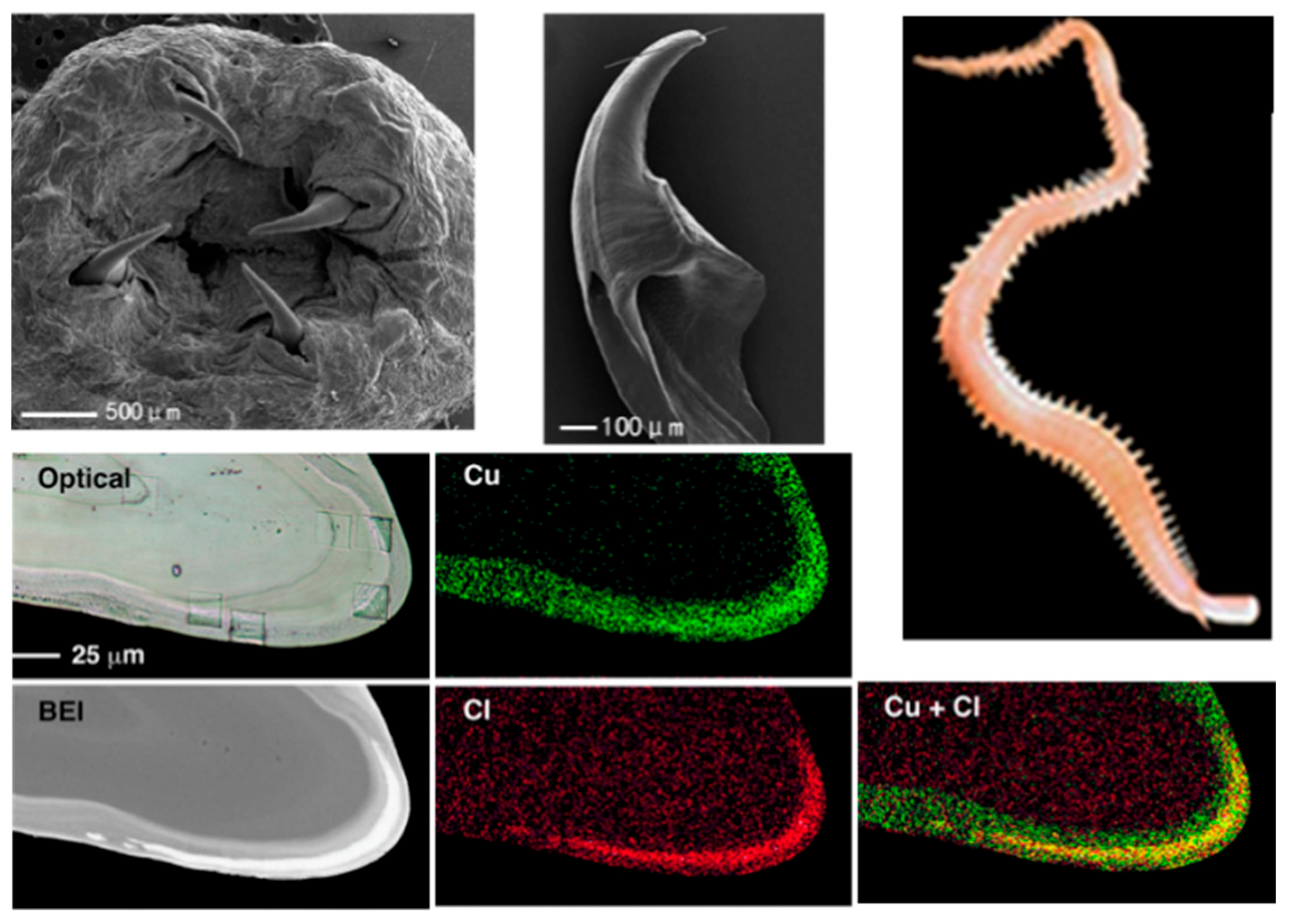
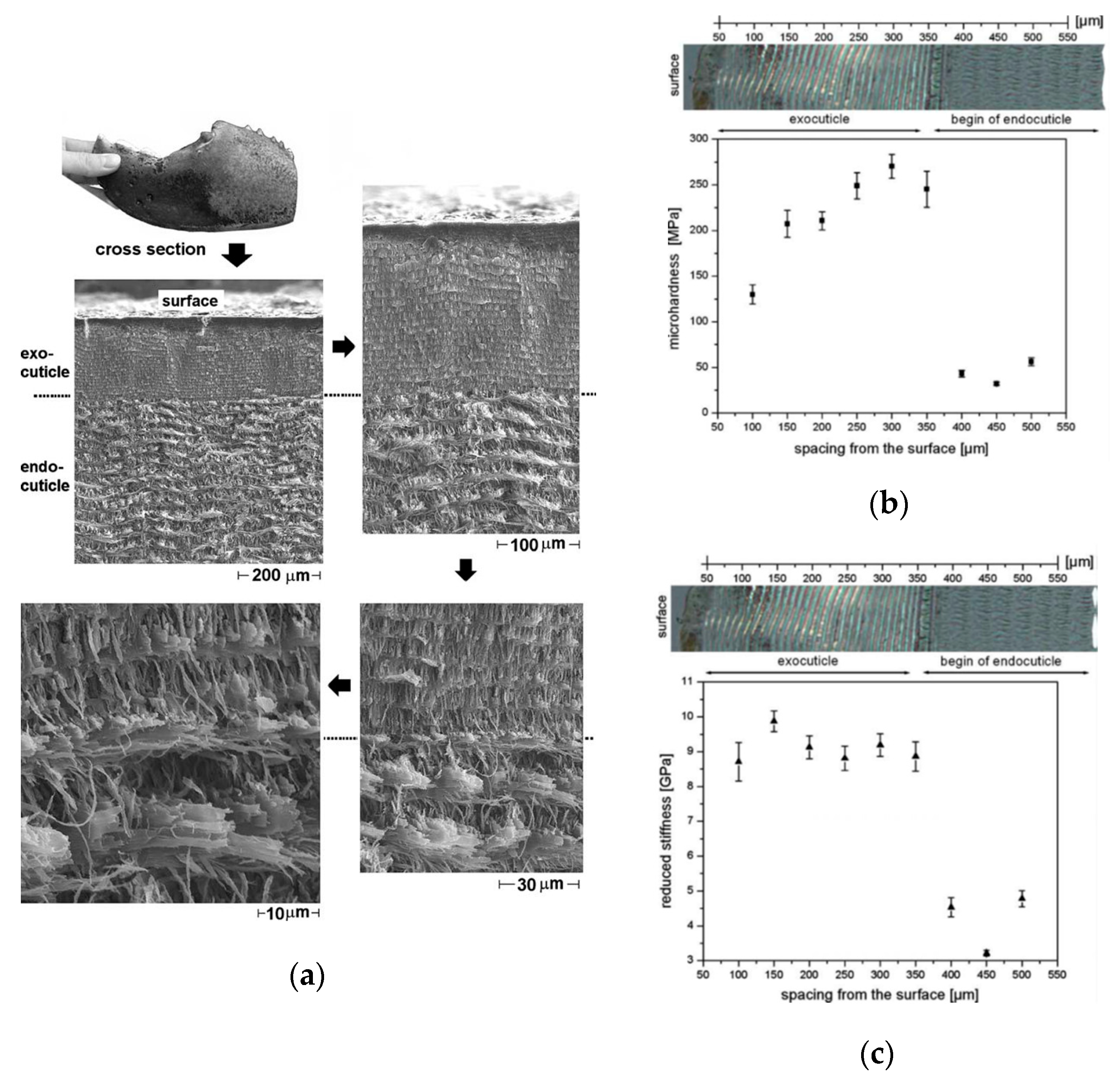

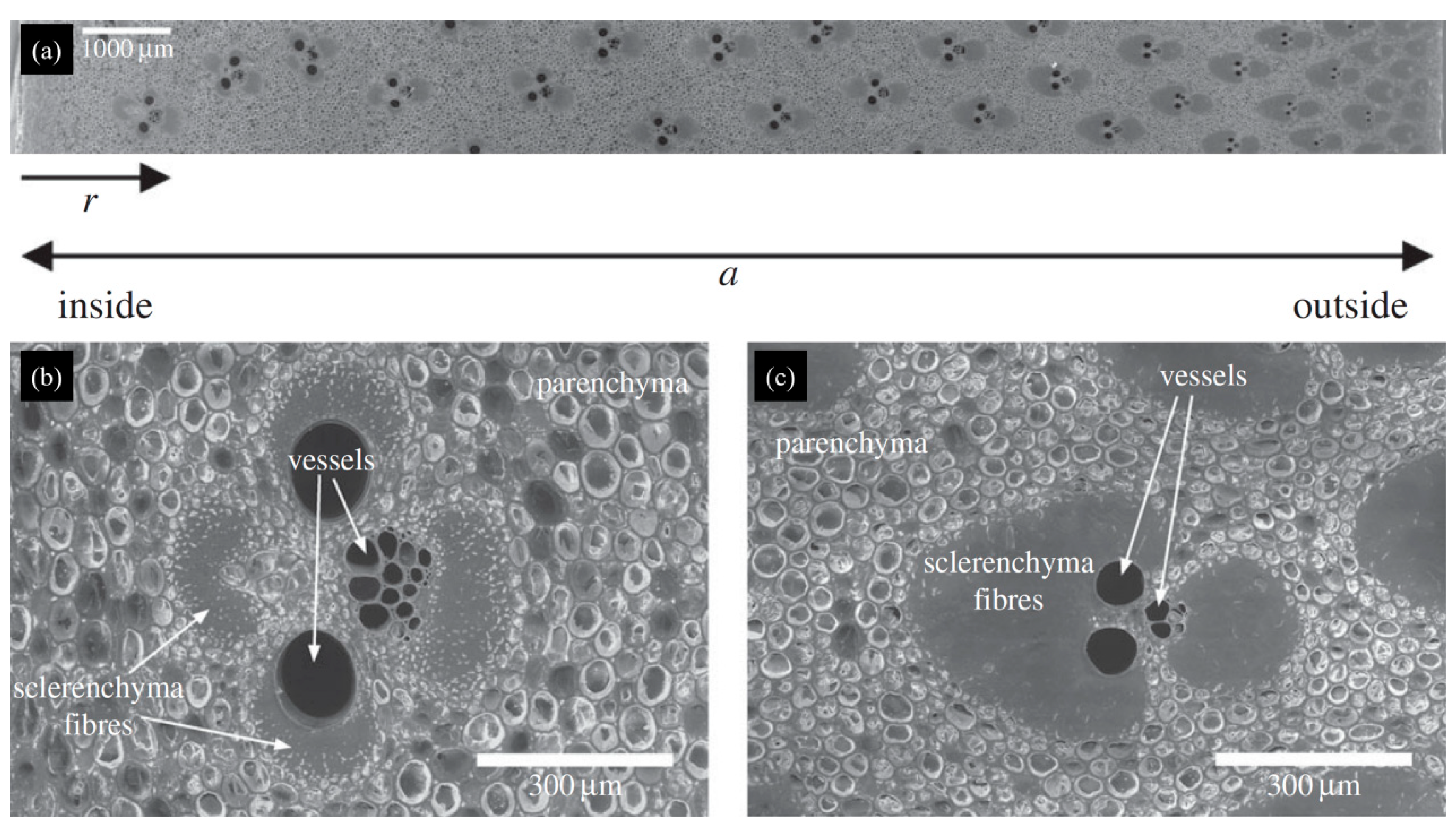
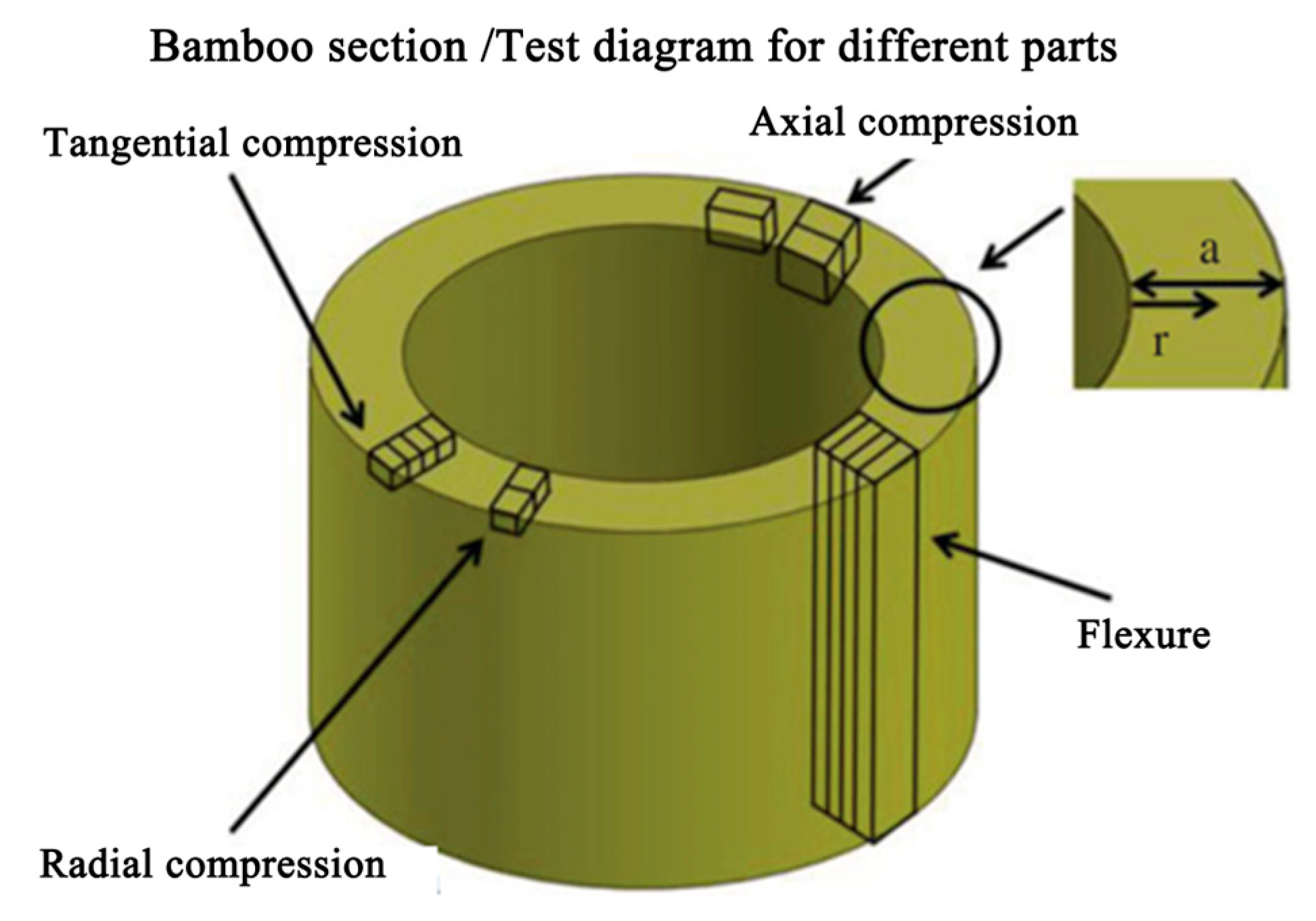
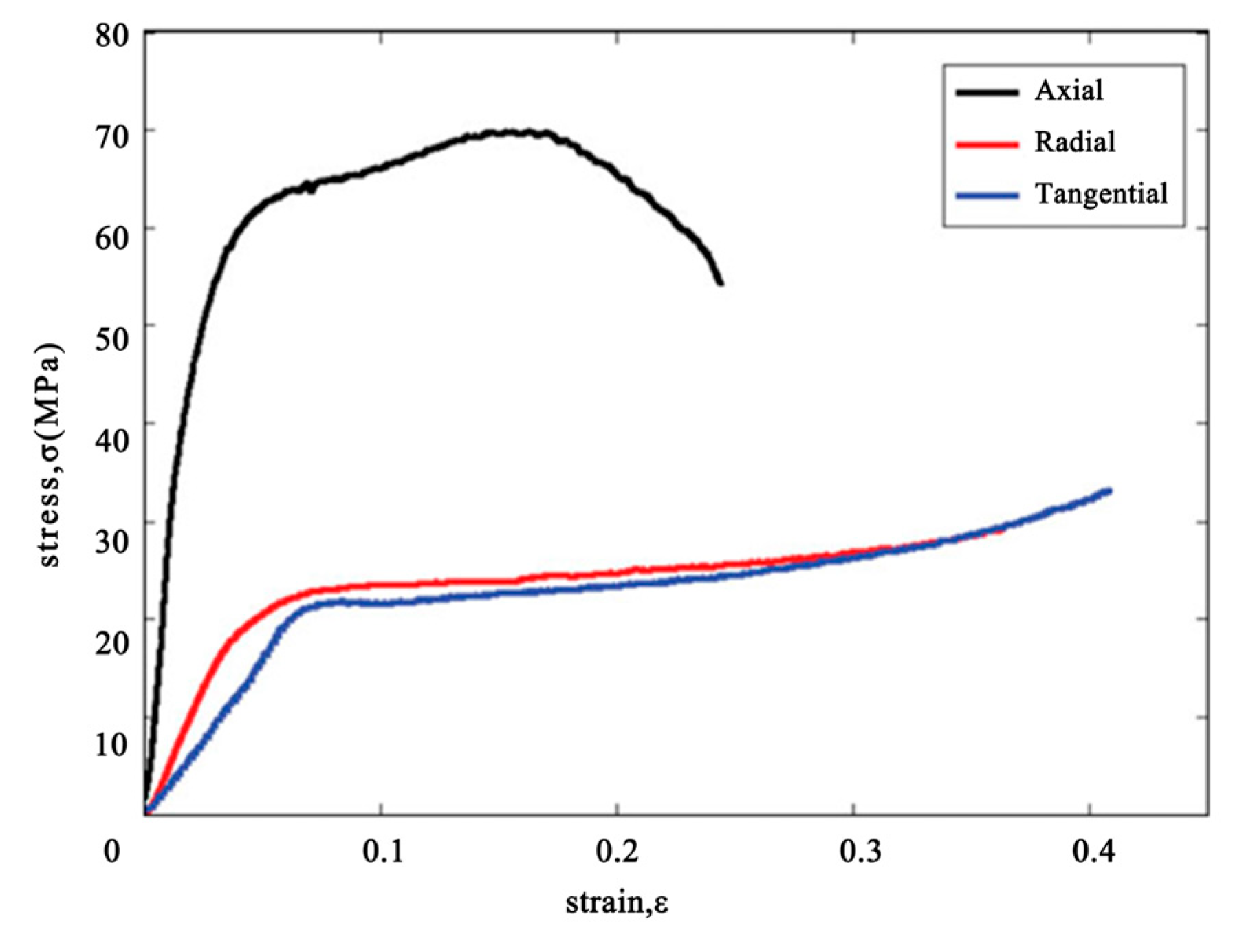
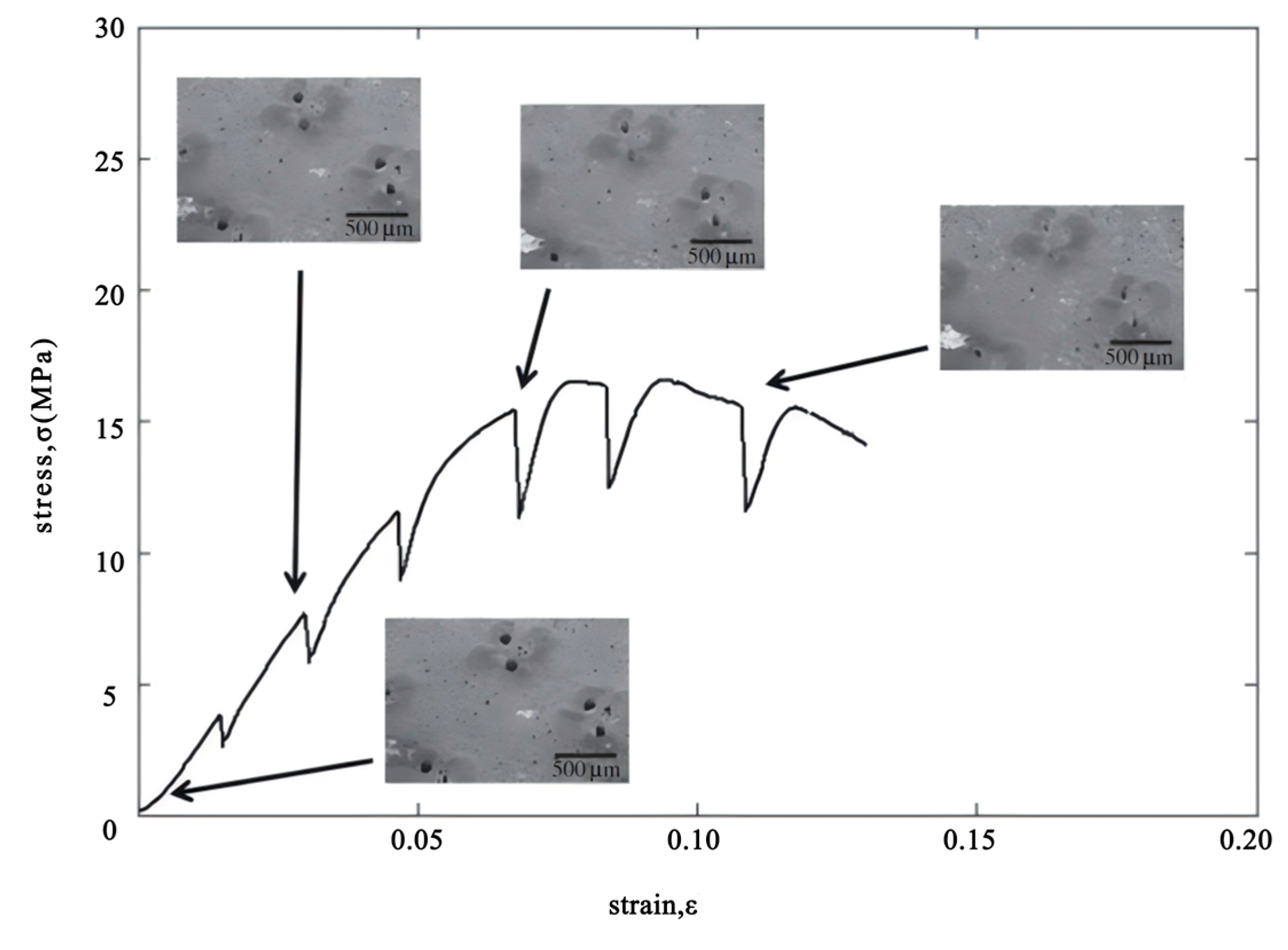

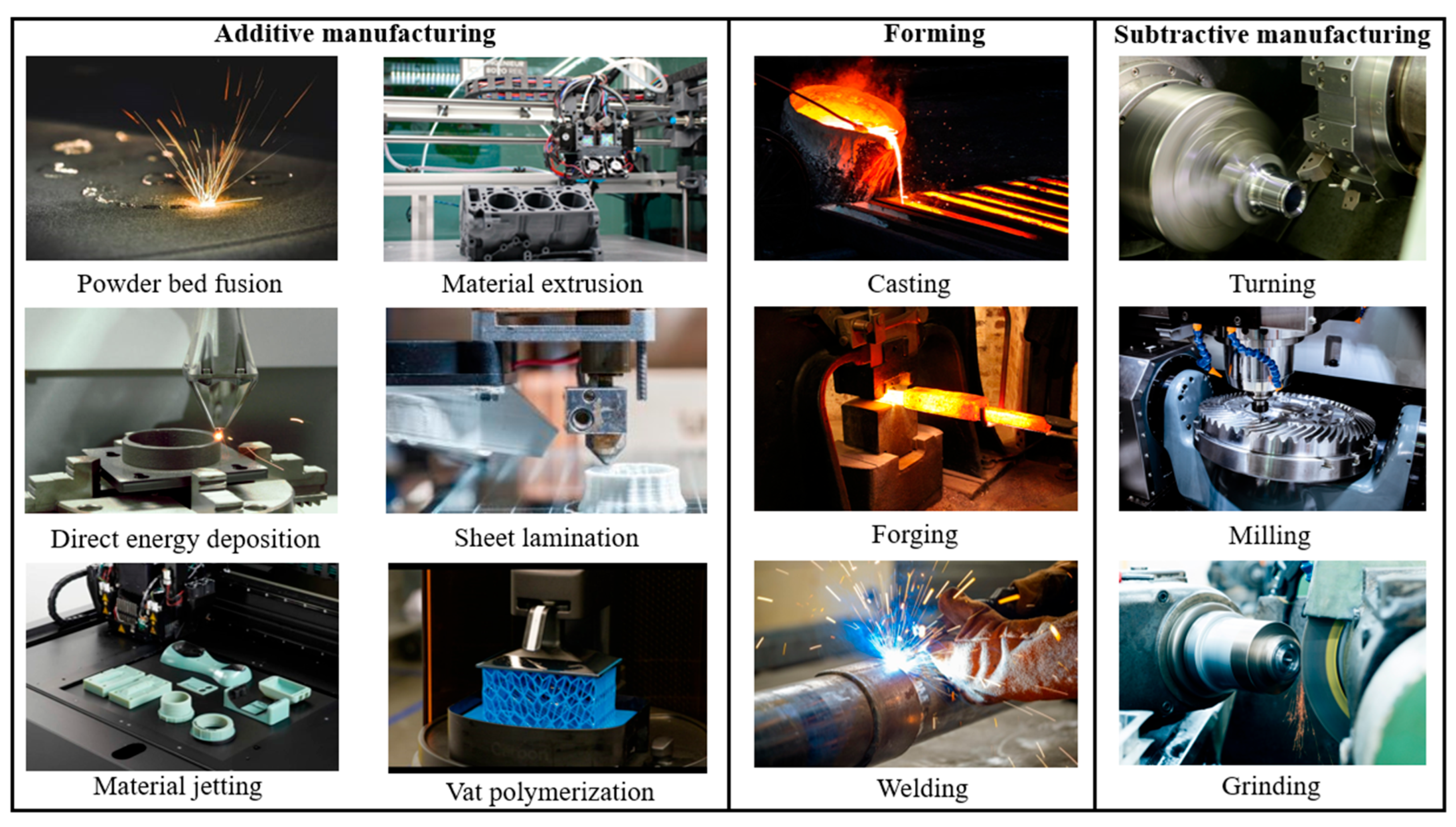
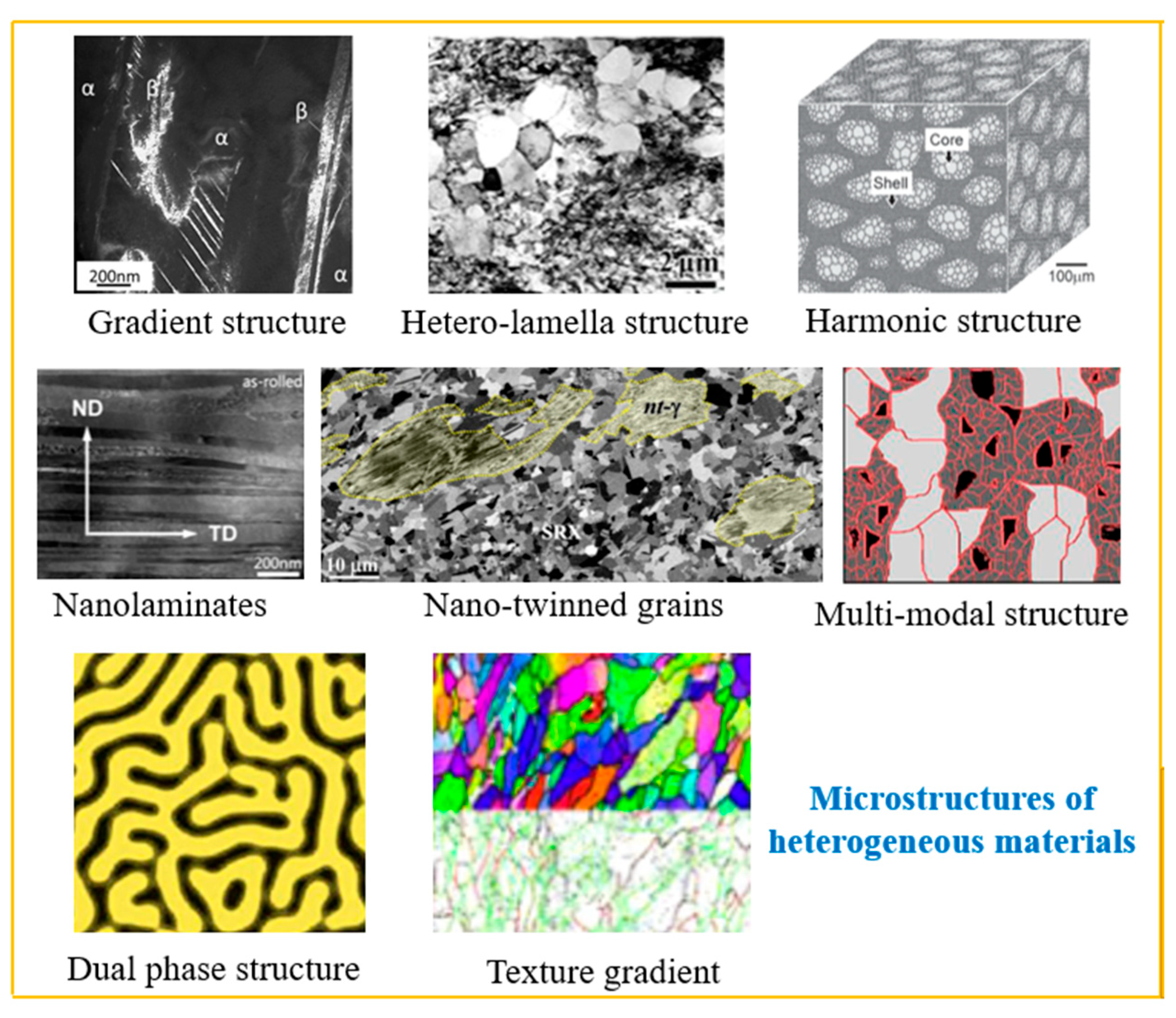
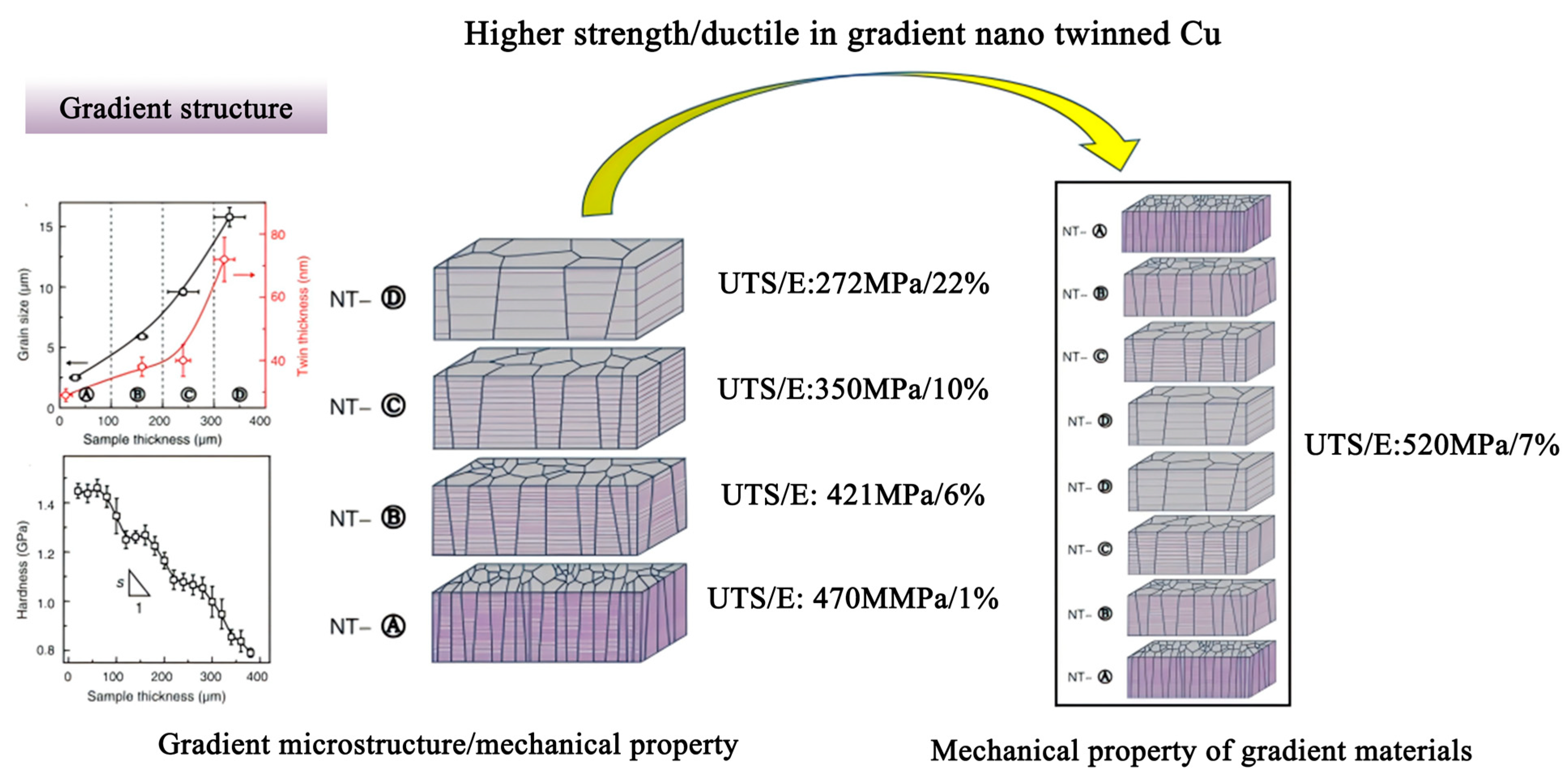
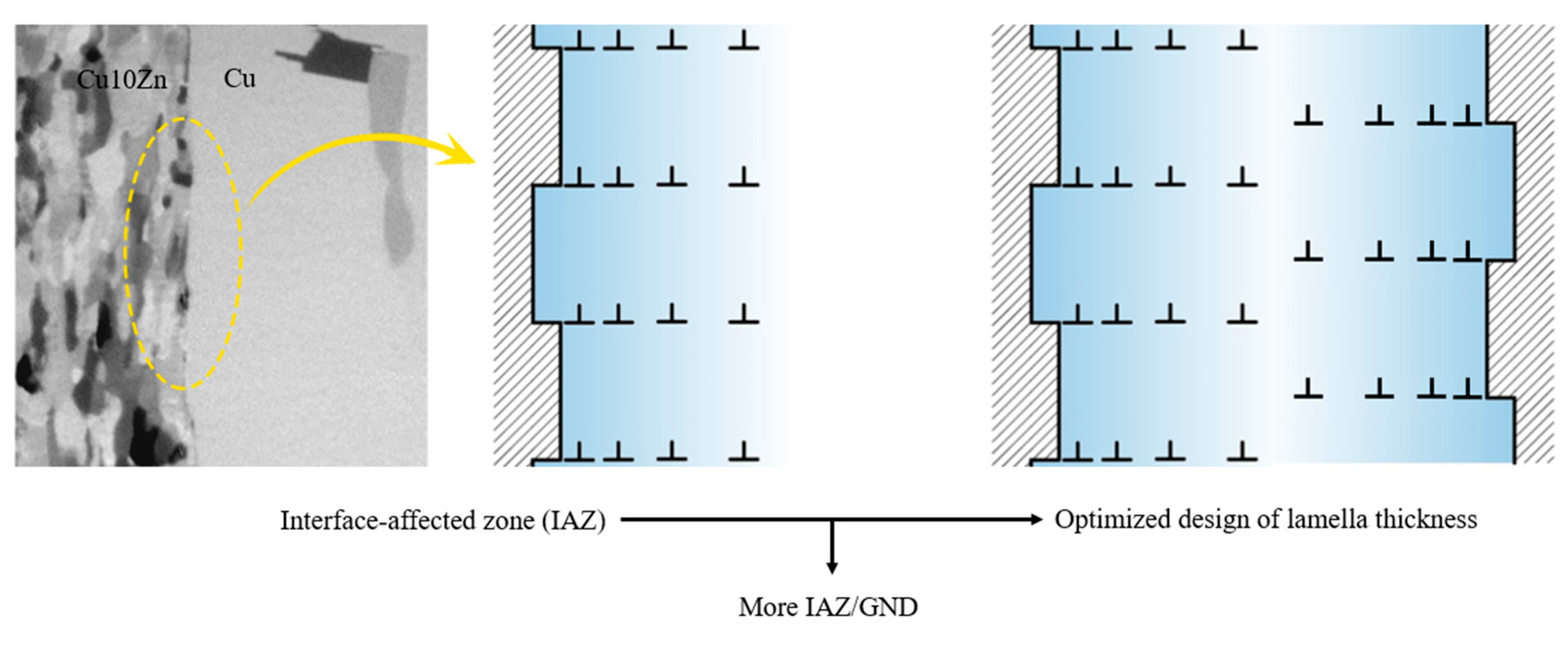
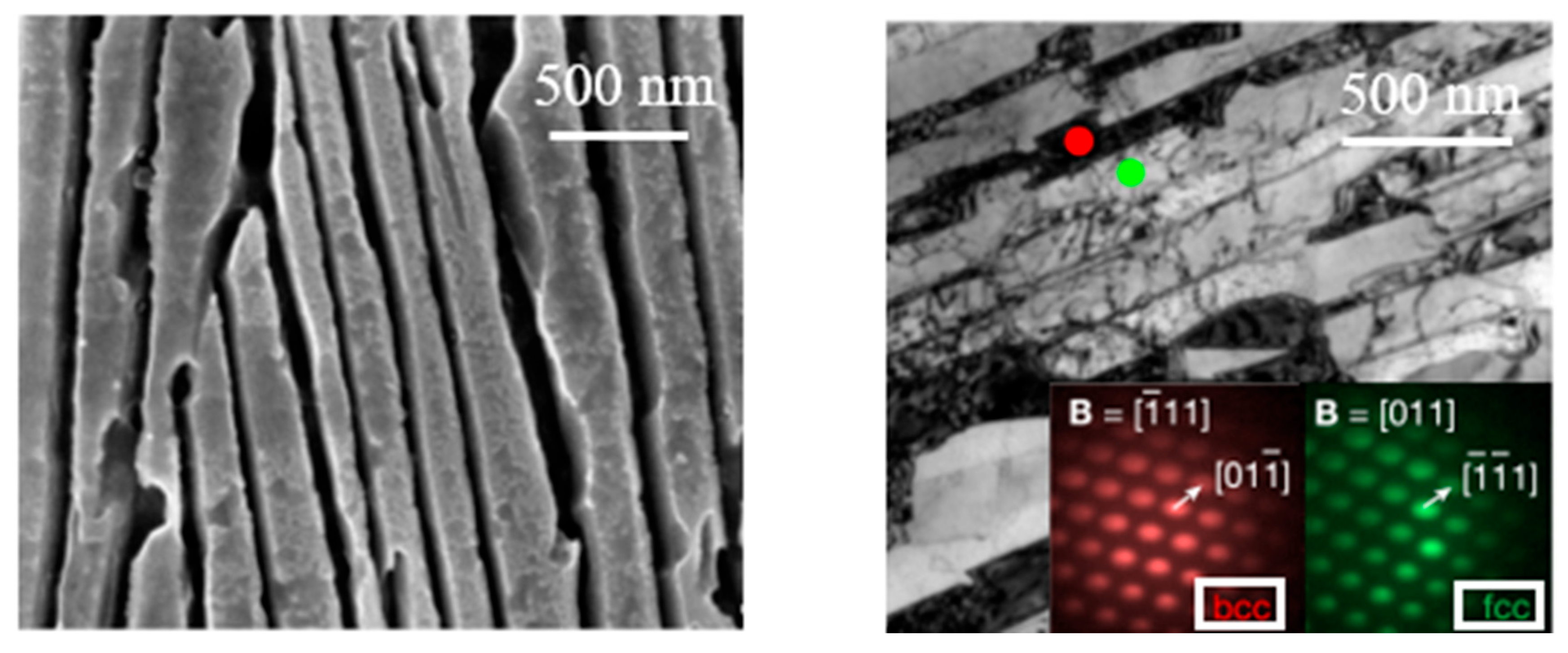
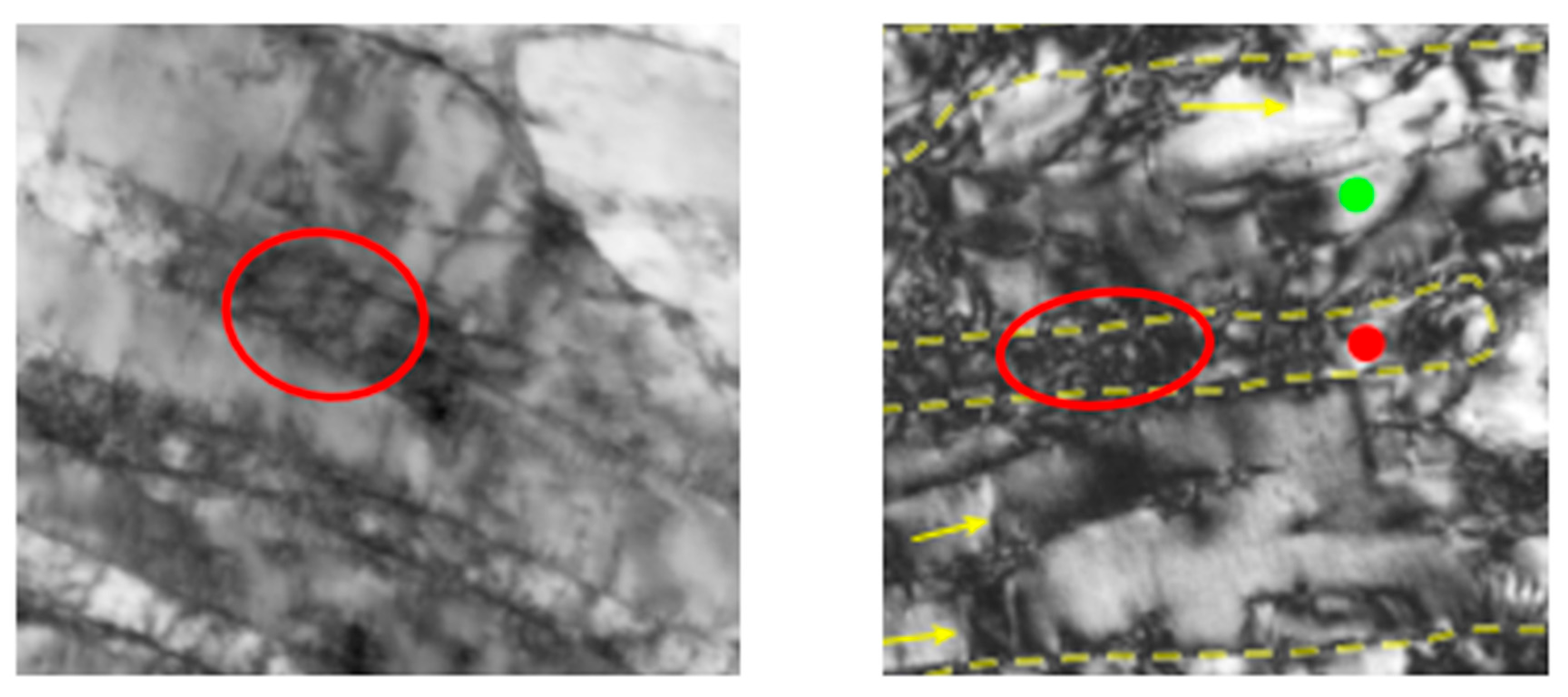
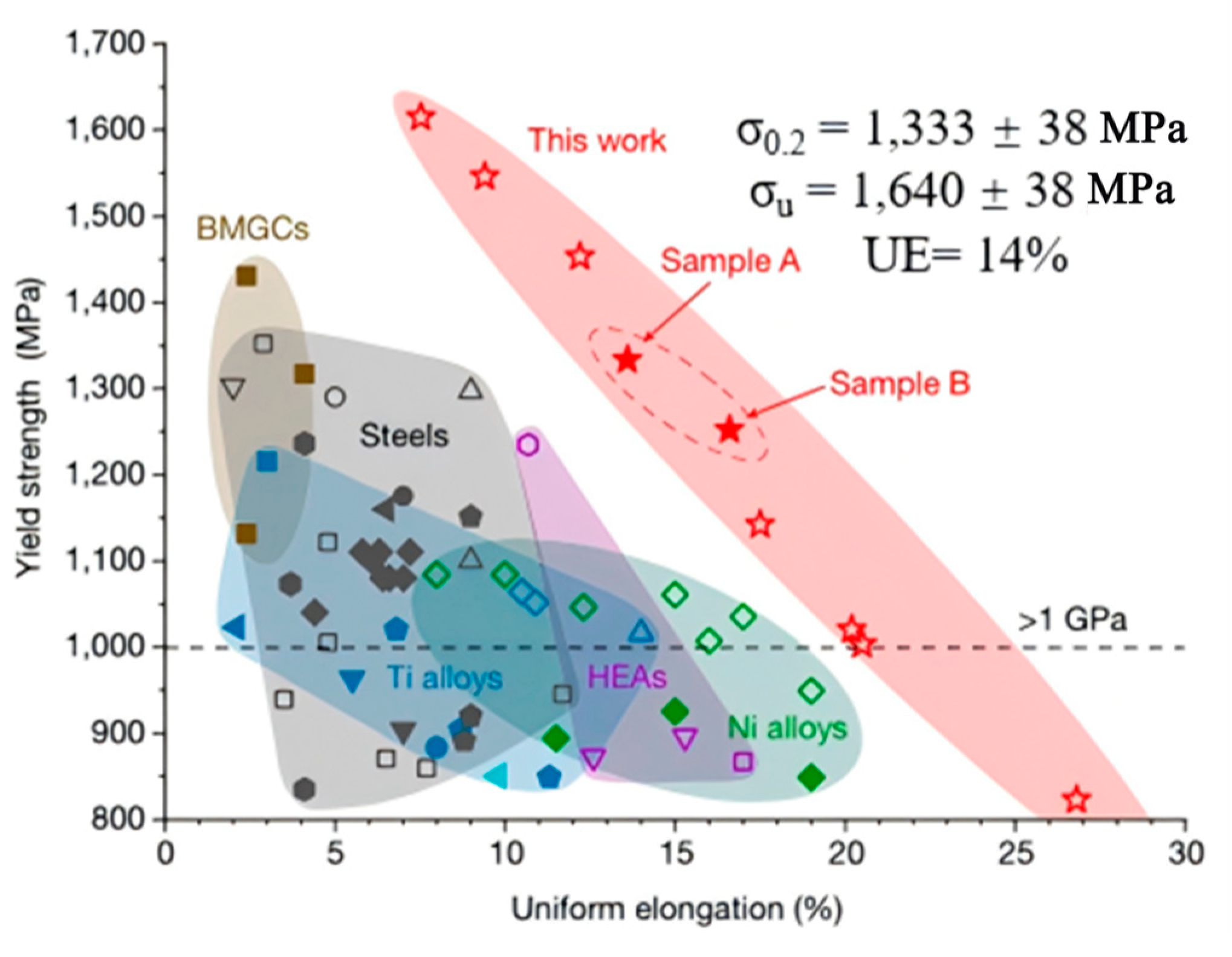
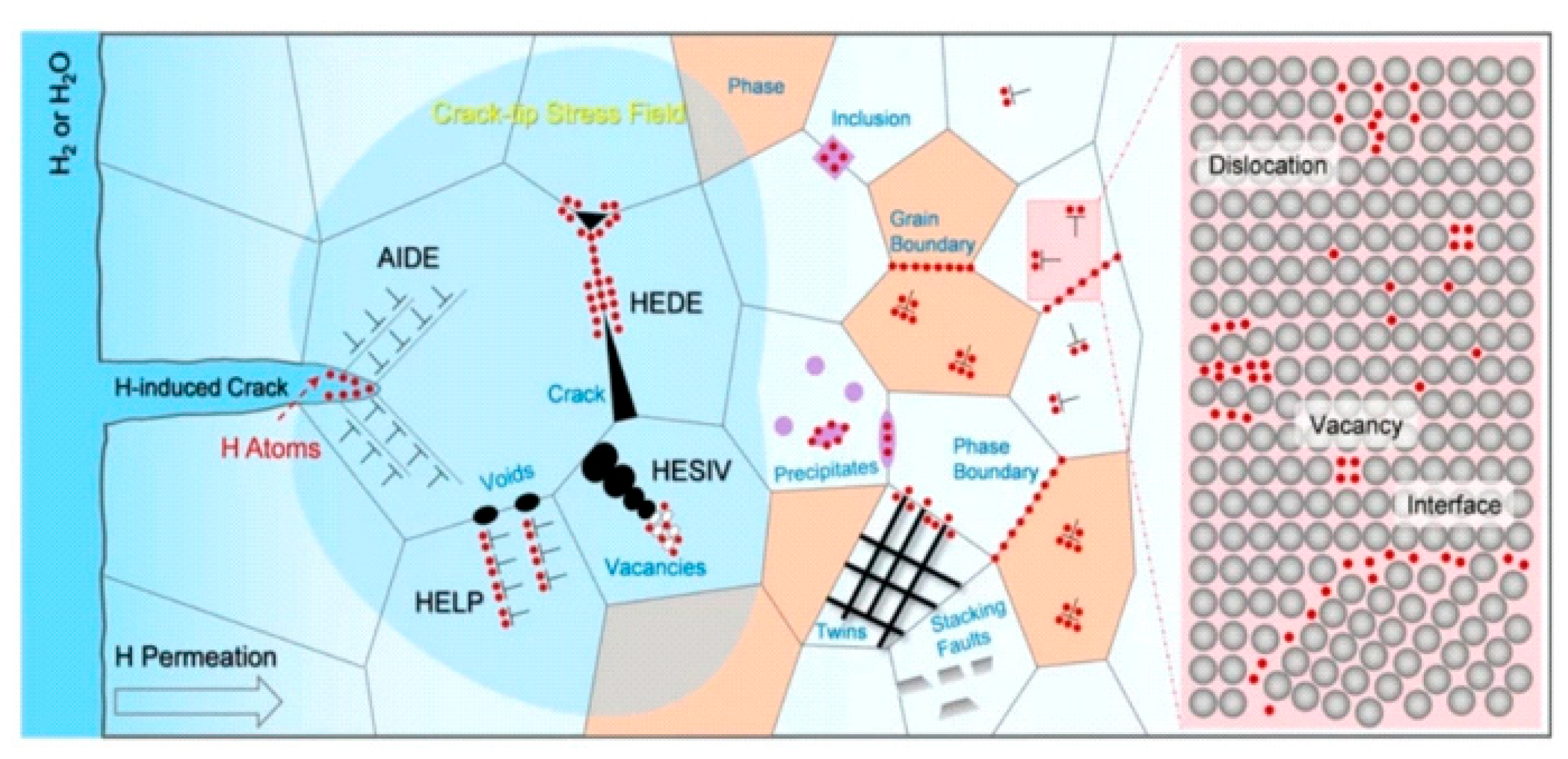
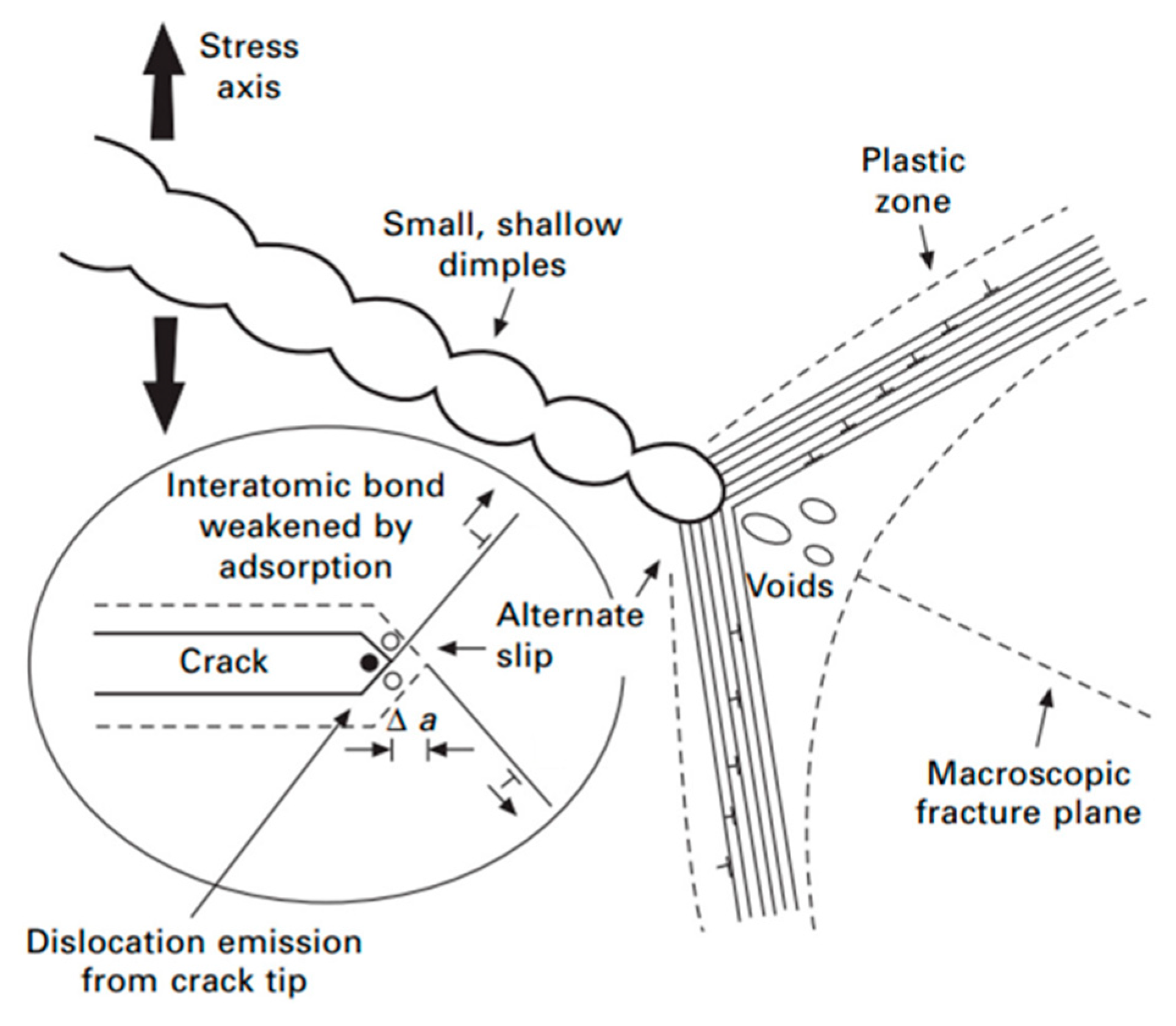

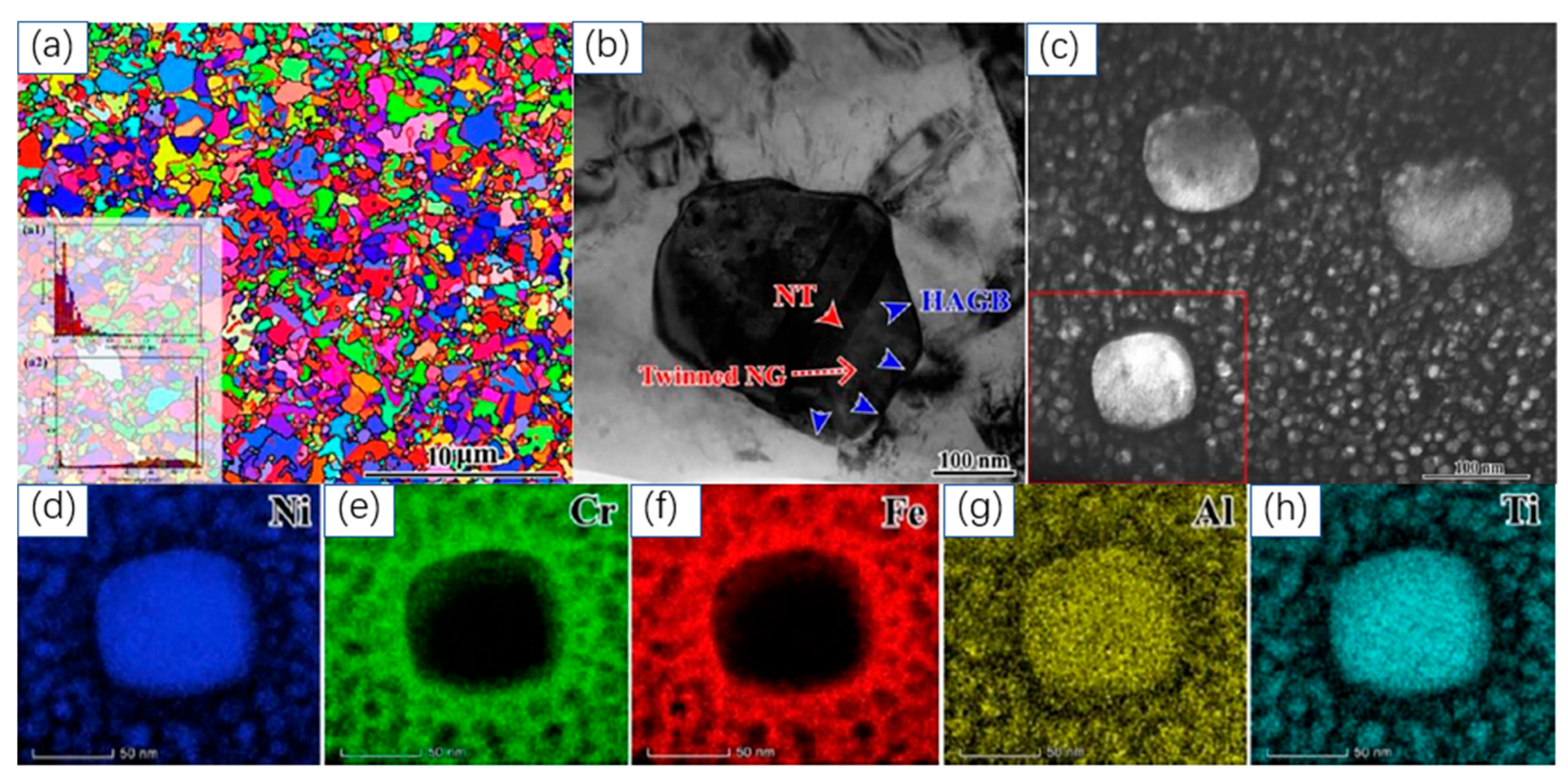
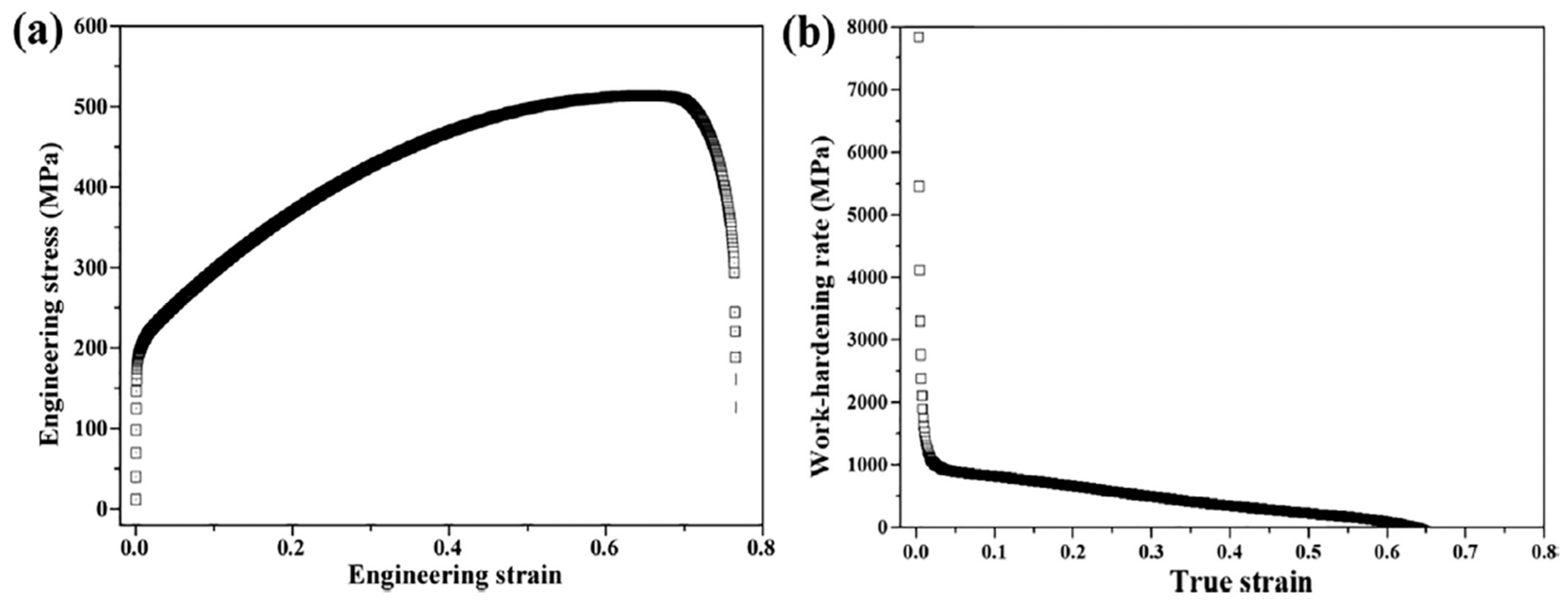
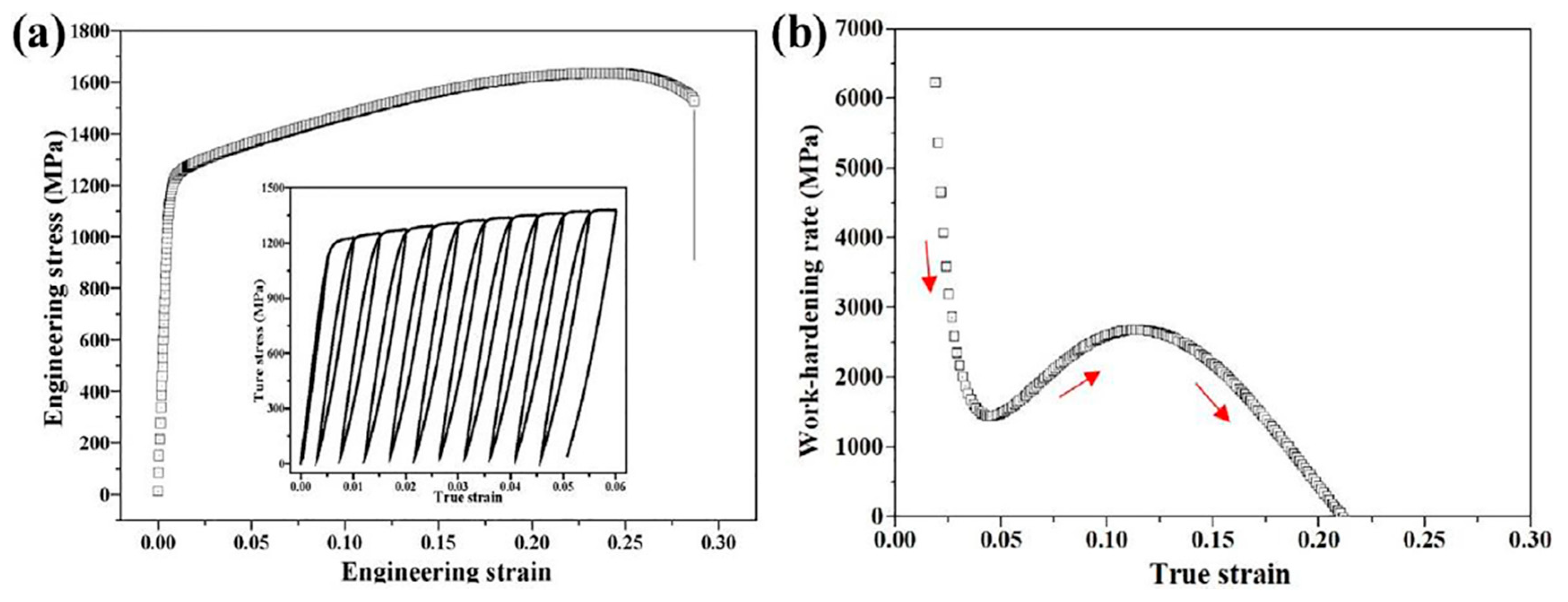
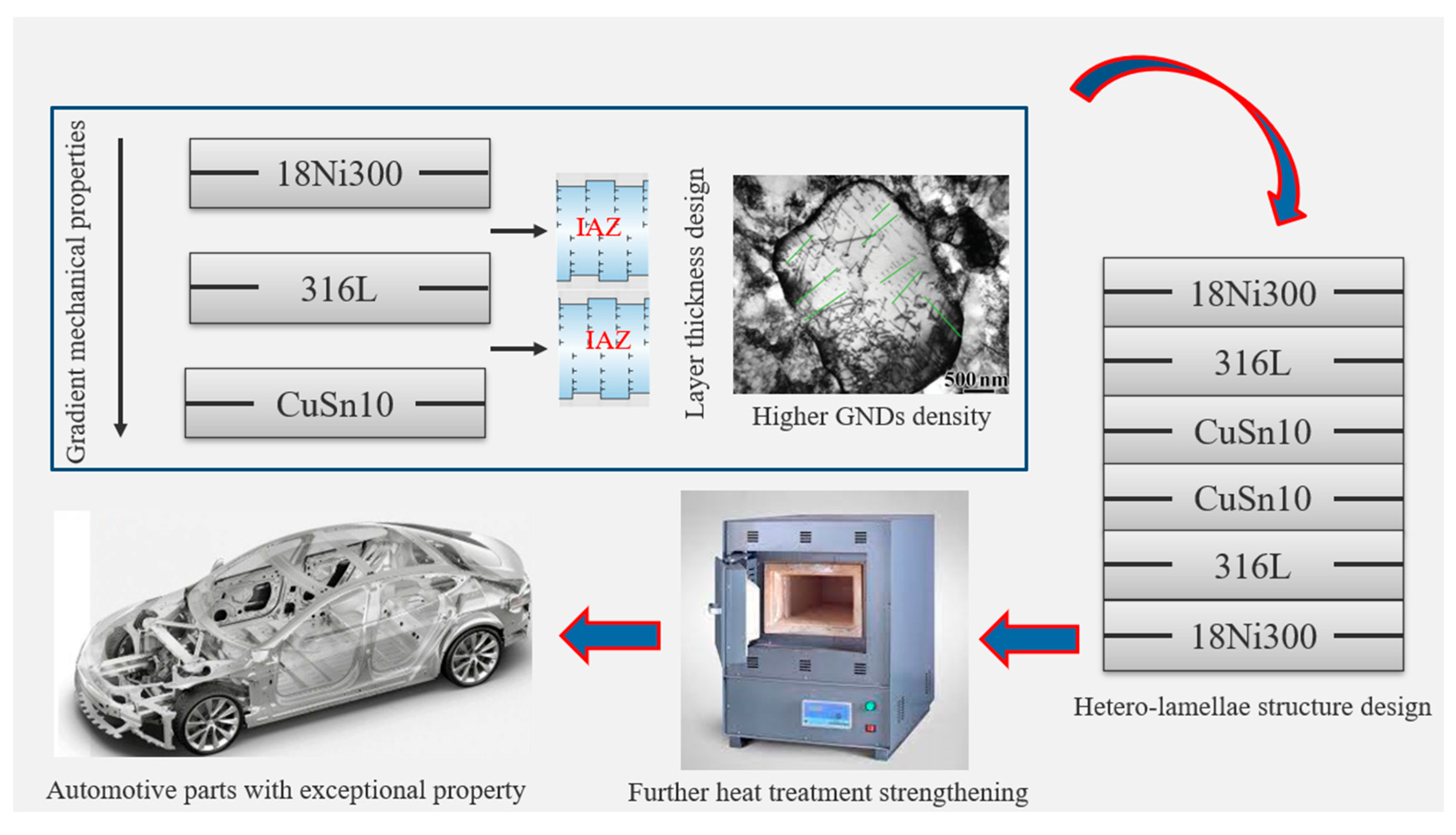
| Phases | Compositions (at.%) | ||||
|---|---|---|---|---|---|
| 70.15 | 5.45 | 6.22 | 5.38 | 12.85 | |
| 62.17 | 11.73 | 12.74 | 5.44 | 7.92 | |
| Bulk material | 41.07 | 25.91 | 27.34 | 3.08 | 2.78 |
Disclaimer/Publisher’s Note: The statements, opinions and data contained in all publications are solely those of the individual author(s) and contributor(s) and not of MDPI and/or the editor(s). MDPI and/or the editor(s) disclaim responsibility for any injury to people or property resulting from any ideas, methods, instructions or products referred to in the content. |
© 2025 by the authors. Licensee MDPI, Basel, Switzerland. This article is an open access article distributed under the terms and conditions of the Creative Commons Attribution (CC BY) license (https://creativecommons.org/licenses/by/4.0/).
Share and Cite
Liu, X.; Wang, W.; Zhao, Y.; Wu, H.; Chen, S.; Wang, L. Nature-Inspired Gradient Material Structure with Exceptional Properties for Automotive Parts. Materials 2025, 18, 4069. https://doi.org/10.3390/ma18174069
Liu X, Wang W, Zhao Y, Wu H, Chen S, Wang L. Nature-Inspired Gradient Material Structure with Exceptional Properties for Automotive Parts. Materials. 2025; 18(17):4069. https://doi.org/10.3390/ma18174069
Chicago/Turabian StyleLiu, Xunchen, Wenxuan Wang, Yingchao Zhao, Haibo Wu, Si Chen, and Lanxin Wang. 2025. "Nature-Inspired Gradient Material Structure with Exceptional Properties for Automotive Parts" Materials 18, no. 17: 4069. https://doi.org/10.3390/ma18174069
APA StyleLiu, X., Wang, W., Zhao, Y., Wu, H., Chen, S., & Wang, L. (2025). Nature-Inspired Gradient Material Structure with Exceptional Properties for Automotive Parts. Materials, 18(17), 4069. https://doi.org/10.3390/ma18174069










